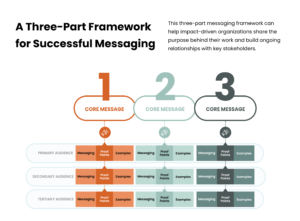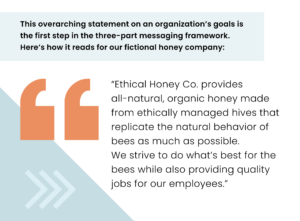A full-funnel marketing strategy starts with a foundational communications framework comprising three parts: A positioning statement, core messages, and key messages. By developing an effective communications framework with these key elements, impact-focused companies can ensure their brand story connects with the right audience and supports their overarching strategic goals. In the first part of our three-part series, we explore why an effective positioning statement is an important foundation for your communications framework, and how to develop yours.
A [purely fictional] organic honey company faced a challenge: Its ethical hive management practices ensured the authenticity of its “organic” status — way beyond the requirements for certification — and its cooperative business model provided a good living for honey collectors in a part of the world where there were few opportunities to earn an income. But once the honey was on the grocery store shelf, it was nearly impossible to distinguish it from the many other brands labeled “organic” and “natural.”
“We print our mission on our label, and we’re posting on social media and our CEO has a blog,” the executive staff said. “But it doesn’t seem to make a difference.”
When asked who is their ideal customer, they replied, “Well, anyone who likes honey.”
While their product was uniquely impactful, the company’s communications challenges were like many others in the impact space: As a company, they were doing so many things right, yet their communications strategy was an afterthought, leading to messaging that was inconsistent, unfocused, and not targeted to anyone in particular.
How could the company convey the reasons their honey cost a bit more than others — that by purchasing it, customers were supporting a variety of critical values such as fair wages, respect for nature, and an innovative business model? And how could they find customers who shared these values and would consistently support them?
The answers lie in an audience-first messaging framework that brings intentionality to every piece of content and uses it to build and engage with the people most likely to become supporters and advocates. But what does successful messaging look like? And what could it do for your organization? What measurable actions will help you know if your initiatives are achieving their goals?
 Three Key Components of an Effective Messaging Framework
Three Key Components of an Effective Messaging Framework
For impact-driven organizations, sharing the purpose behind their work is among the most important ways to build deep and mutually beneficial relationships with audience members. People today want to support brands and organizations with values aligned with their own. This demand places an imperative on storytelling to convey why people should consider building a lasting relationship with your organization.
Three key components of an effective messaging framework form the basis of your impact communications: your positioning statement, core messages, and key messages. Together, these components get your most important stakeholders to not only notice what you have to say but to build an ongoing relationship with you and take action.
Though grounding your work in an accurate and compelling mission is important, a single statement is not enough to build relationships and drive actions with today’s savvy and time-strapped consumers and audiences. Instead, your organization’s mission and values must be conveyed through authentic, strategic messages that will compel your most important audience members to take meaningful actions aligned with your goals — whether that means buying, donating, volunteering, partnering, or advocating.
 What to Consider When Creating a Powerful Positioning Statement
What to Consider When Creating a Powerful Positioning Statement
A foundational step toward developing your organization’s messaging framework is creating a positioning statement. Your positioning statement is an overarching message that incorporates your mission and goals — how you show up in the world, why you exist, and what makes you unique or necessary in the space you work in.
Think of it as your quick elevator pitch. It answers questions such as what needs your organization addresses and why; how your organization addresses them; and the positive impact of your organization’s work with a focus on your target audience. These components make up a positioning statement:
- People you serve
- Statement of need
- Type of organization
- Service
- Benefit of service
- Point of differentiation
Once these components are identified, the following provides a template for using them to create a positioning statement: “For (people you serve) who (statement of need), ORGANIZATION is a (type of organization) providing (service) that (benefit of service.) Unlike other organizations addressing this issue, we (point of differentiation.)”
Let’s try filling in the template for our hypothetical ethical honey company:
For people who care about honey bee health and natural hive management, “Ethical Honey Co.” is a honey producer providing pure, organic honey from ethically managed hives. Unlike many other honey companies, we do what’s best for the bees while also providing quality jobs.
After you’ve answered these questions and formed your positioning statement using the template above, consider rewriting it in a more natural tone while preserving the essential points. A good positioning statement serves as a shared organizational value that identifies why you exist, who you serve, and how you show up in your space. It is likely not going to be shared publicly but serves as an anchor for your communications framework.
Let’s make this positioning statement sound more natural:
Ethical Honey Co. provides all-natural, organic honey made from ethically managed hives that replicate the natural behavior of bees as much as possible. We strive to do what’s best for the bees while also providing quality jobs for our employees.
The positioning statement forms the basis of the rest of the communications framework. The positioning statement can be broken down into your organizational core messages, each of which is a statement or takeaway you want someone to learn about your organization. Your core messages can then be used as material for constructing key messages for each of your stakeholder audiences. These messages directly address your audience member’s interests and needs.
In our next installment, we’ll move on to core messages — the foundational statements that form the basis of your organization’s entire messaging framework.
 What to Consider When Creating a Powerful Positioning Statement
What to Consider When Creating a Powerful Positioning Statement